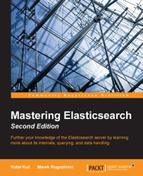- Mastering Elasticsearch Second Edition
- Table of Contents
- Mastering Elasticsearch Second Edition
- Credits
- About the Author
- Acknowledgments
- About the Author
- Acknowledgments
- About the Reviewers
- www.PacktPub.com
- Preface
- 1. Introduction to Elasticsearch
- 2. Power User Query DSL
- Default Apache Lucene scoring explained
- Query rewrite explained
- Query templates
- Handling filters and why it matters
- Choosing the right query for the job
- Query categorization
- The use cases
- Summary
- 3. Not Only Full Text Search
- Query rescoring
- Controlling multimatching
- Significant terms aggregation
- Documents grouping
- Relations between documents
- Scripting changes between Elasticsearch versions
- Summary
- 4. Improving the User Search Experience
- Correcting user spelling mistakes
- Improving the query relevance
- Summary
- 5. The Index Distribution Architecture
- 6. Low-level Index Control
- Altering Apache Lucene scoring
- Choosing the right directory implementation – the store module
- NRT, flush, refresh, and transaction log
- Segment merging under control
- When it is too much for I/O – throttling explained
- Understanding Elasticsearch caching
- The filter cache
- The field data cache
- The shard query cache
- Using circuit breakers
- Clearing the caches
- Index, indices, and all caches clearing
- Summary
- 7. Elasticsearch Administration
- Discovery and recovery modules
- The human-friendly status API – using the Cat API
- Backing up
- Federated search
- Summary
- 8. Improving Performance
- Using doc values to optimize your queries
- Knowing about garbage collector
- Benchmarking queries
- Very hot threads
- Scaling Elasticsearch
- Vertical scaling
- Horizontal scaling
- Using Elasticsearch for high load scenarios
- Summary
- 9. Developing Elasticsearch Plugins
- Creating the Apache Maven project structure
- Understanding the basics
- Creating custom REST action
- Creating the custom analysis plugin
- Implementation details
- Implementing TokenFilter
- Implementing the TokenFilter factory
- Implementing the class custom analyzer
- Implementing the analyzer provider
- Implementing the analysis binder
- Implementing the analyzer indices component
- Implementing the analyzer module
- Implementing the analyzer plugin
- Informing Elasticsearch about our custom analyzer
- Testing our custom analysis plugin
- Implementation details
- Summary
- Index
In this chapter, we extended our knowledge about query handling and data analysis. First of all, we discussed query rescore, which can help us when we need to recalculate the score of the top documents returned by a query. We also learned how to control multimatching queries. After that, we looked at two new aggregation types—one allowing us to get significant terms from a set of results and the other allowing documents grouping: a highly anticipated feature. We also discussed differences in relationship handling and approaches we can take when using Elasticsearch. Finally, we extended our knowledge about the Elasticsearch scripting module and we've learned what changes were introduced after Elasticsearch 1.0.
In the next chapter, we will try to improve our user query experience. We will start with user spelling mistakes and how Elasticsearch can help us by turning mistakes into good queries. We will also see what approaches we can take to handle user spelling mistake situations. After that, we will discuss improving query relevance on a given example. We will show you a query returning poor results and we will tune the query to match our needs.
-
No Comment
